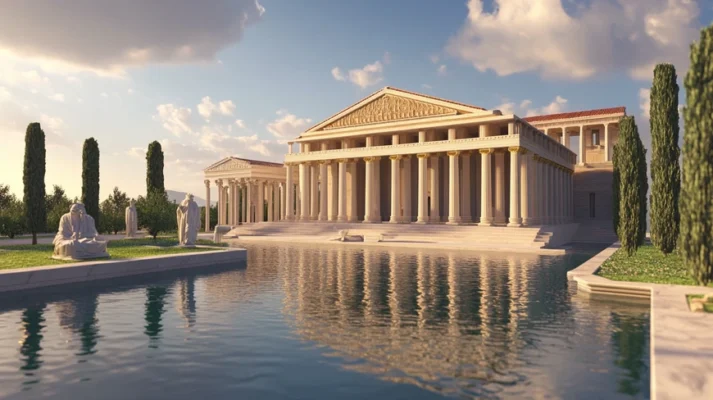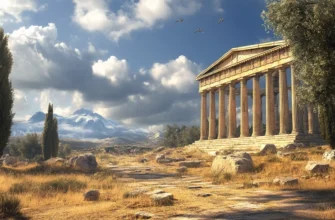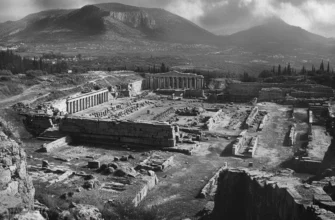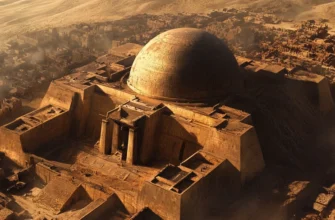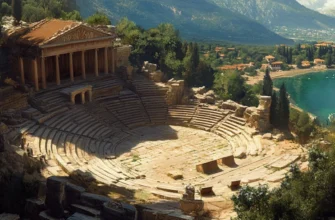Malia is one of the largest and most important cities of Ancient Greece, located on the island of Crete. This city became a significant center of Cretan civilization during the Mycenaean period (around 1450–1100 BC), when culture, art, and trade were actively developing on Crete.
One of the main archaeological sites is the Palace of Mallia, which was one of the three main palaces on the island, along with Knossos and Phaistos. The palace was huge and had a complex architecture, with lots of courtyards, rooms, and storage areas, showing how organized and cultured people were back then.
Malia is also known for its interaction with other Mediterranean civilizations, as evidenced by numerous archaeological finds, including written tablets in Linear B script. The city has experienced periods of decline, but the remains of its culture still attract the attention of archaeologists and tourists.
Today, Malia is an important tourist destination where you can explore not only archaeological ruins but also immerse yourself in the atmosphere of ancient Crete while learning about the legacy of this ancient civilization.
- History of Malia
- The emergence and founding of the city
- Development and influence of the Minoan civilization
- Archaeological excavations
- The role of archaeology in understanding the history of Malia
- Architecture and main attractions
- Main attractions
- The role of the palace in the life of the city
- Description of large rooms and courtyards
- Functional zoning of courtyards and rooms
- Water supply and sewage systems
- Malia in cultural heritage
- Mallia as part of the world’s cultural heritage
- Conclusions
History of Malia
Malia, one of the most important cities of ancient Crete, has a rich and complex history. The city is located in the northeast of the island, and its history spans several important periods, from the Neolithic to the decline at the end of the Mycenaean period.
Malia was founded in the early period of Cretan civilization, probably in the middle of the 2nd millennium BC. Archaeological excavations show that large settlements built of stone and clay already existed in the city at that time. This place was an important economic and commercial center that played a significant role in the development of the Cretan civilization.
Around 1450 BC, Mallia experienced its heyday when the city became one of the important centers in Crete. This was due to the influence of the Mycenaean civilization, which conquered the island after the fall of the Minoan Empire. At that time, a huge palace was built, which became the administrative, economic, and religious center of the city.
The palace of Malia was similar to other palaces in Crete, with numerous courtyards, corridors, and warehouses. It also had a water supply and sewage system, which shows how advanced engineering was back then. Like other Cretan cities, Malia fell into decline in the mid-12th century BC, when the island was invaded by sea peoples and a period of social and economic change began.
The palace was abandoned, and the city began to decline.
However, archaeological research continues to this day. Excavations in Malia have uncovered many important artifacts, including tablets written in Linear B script, which indicate interaction with other Mediterranean cultures.
Although Mallia fell into decline, it left behind a rich cultural and archaeological heritage. Today, the city is an important tourist attraction, and its ruins continue to attract archaeologists and visitors eager to touch the history of ancient Crete.
The emergence and founding of the city
The city of Malia in Crete has an ancient history dating back to the Neolithic period. According to archaeological data, Malia was founded around 2000 BC against the backdrop of the development of the early Cretan civilization, which was actively developing on the island at that time.
Mallia is located on flat land near the coast, which provided it with a favorable strategic position for trade and interaction with other Mediterranean cultures. This location was chosen because of its fertile land, which was ideal for agriculture and livestock breeding. In addition, the proximity to the sea allowed for the development of maritime trade, which became an important part of the city’s economy.
The first settlements on the territory of Malia appeared as early as the Neolithic period, around 3000 BC, when people began to cultivate the land and build permanent settlements. Over time, the city became an important center of the region, and the need for a more complex organization of life arose, which led to the development of urban planning and the creation of the first architectural structures.
Development and influence of the Minoan civilization
With the emergence of the Minoan civilization (around 2000 BC), Malia gradually became an important city in Crete. Thanks to its convenient location for maritime trade, the city became one of the main trading centers.
At this time, the first palaces and administrative buildings appeared, indicating the beginning of centralization and the development of a complex social structure. Mallia became part of a large network of cities that cooperated with each other, ensuring the stability of the Cretan economy.
Mycenaean period
Several centuries later, in the middle of the 2nd millennium BC, the Mycenaeans arrived in Crete, bringing with them new cultural influences. Malia became one of the main centers of Mycenaean civilization on the island, and during this period, the city reached its peak.
A huge palace was built, which became the administrative, religious, and economic center. The city became an important hub on the trade routes between the East and the West.
Thus, the founding and early development of Malia were closely linked to the growth and changes in the culture, economy, and social structure of Crete, and its strategic location contributed to the city’s prosperity over the centuries.
Periods of decline and revival
Like many other centers of Cretan civilization, the city of Malia went through several stages of decline and revival, reflecting the general processes that took place on the island during different historical periods.
Decline at the end of the Minoan period (around 1450 BC)
The Minoan civilization, during whose heyday Malia reached its peak, began to experience the first signs of decline as early as the middle of the 2nd millennium BC.
This was caused by various factors, including natural disasters (in particular, a possible volcanic eruption on the island of Santorini), social and economic changes, and invasions by other peoples.
Around 1450 BC, Crete was severely attacked by the Mycenaeans, who invaded the island and changed the political situation. The palace of Malia was damaged, and the city became part of the new Mycenaean structure. Although the city was not completely destroyed, Malia’s importance declined significantly, and the palace no longer enjoyed the same level of power and economic prosperity as before.
Transition to the Mycenaean period (around 1450–1200 BC)
Despite the decline of the Minoan culture, Malia did not disappear completely, and the city came under the control of the Mycenaeans, who brought with them new architectural and cultural influences. The palace, although restored after damage, already had the characteristic features of Mycenaean architecture, in particular fortifications, which corresponded to changes in the city’s defensive needs.
However, over time, new crises began to emerge in Crete. The decline of the Mycenaean civilization, associated with invasions by sea peoples and internal social conflicts, also affected Malia. The palace gradually fell into disrepair, and the city lost its former grandeur.
Decline during the Sea Peoples period (around 1200 BC)
At the end of the 12th century BC, during the invasion of the Sea Peoples, which caused the fall of the Mycenaean civilization, Malia experienced its last major phase of decline. The city was abandoned, and most of the buildings, including the palace, were partially destroyed or burned down.
Revival in the Greek period (1st millennium BC)
After its decline during the Sea Peoples period, Mallia remained abandoned for several centuries. However, already in the Greek period, decline was replaced by a partial revival. This was linked to the revival of Greek culture in Crete, when the Mediterranean islands once again became important commercial and cultural centers. Malia began to revive thanks to the development of trade, the restoration of agriculture, and new contacts with other Greek cities.
However, although the city never regained its former glory, its role in the history of Crete and Greece remained important.
Decline and subsequent oblivion
As a result of the Roman conquest of Crete in the 1st century BC and the subsequent integration of the island into the Roman Empire, many ancient cities, including Malia, fell into decline and were forgotten. However, the ruins of the city remained a testament to its former prosperity, and archaeological research later made it possible to reconstruct part of its history.
Archaeological excavations
Archaeological excavations at Malia in Crete began in the late 19th century, and today it is one of the most important sites for studying ancient Cretan civilization. They have uncovered many valuable artifacts that have helped reconstruct the history of the city, its culture, and daily life at various stages of its existence.
Excavations on the palace grounds
One of the main sites of archaeological excavations is the palace of Malia. The palace was discovered in 1915 by French archaeologist Armand-Jacques Dupre, and its excavation began during the French archaeological mission in Crete. The architecture of the palace is similar to other Cretan palaces, such as Knossos and Phaistos, but it has unique features.
Excavations of the palace have revealed huge courtyards, numerous rooms, warehouses, and even religious buildings. Of particular interest are the frescoes and mosaics found on the walls of the palace, as well as numerous tablets with Linear B script, which confirm the role of Malia as an administrative and commercial center.
Finds and artifacts
One of the main archaeological finds were tablets with Linear B script, confirming the important role of Malia in the Mycenaean period. This script was used for administrative and commercial records, and the tablets found provide valuable information about the economy, social organization, and interaction of Malia with other cities and civilizations.
Numerous ceramic artifacts were also discovered, which helped to understand the level of development of crafts and trade relations in the city. Many of these items have decorative elements that testify to the high level of craftsmanship.
The frescoes found in the palace are important evidence of Malia’s culture. They depict various scenes from religious life, as well as the flora and fauna that were part of the daily life of the city’s inhabitants.
Other important finds
Numerous tombs were also discovered during the excavations, providing insight into the burial rites of the time. Some of them contained items that testify to the high status of the buried persons, including precious jewelry and other luxury items.
One of the important aspects of the archaeological excavations was the discovery of a water supply and sewage system in the palace, which indicates a high level of engineering and organization of the city’s life.
The role of archaeology in understanding the history of Malia
The excavations at Malia play a key role in understanding the culture and history of Ancient Crete. They allow us not only to reconstruct the architectural and material aspects of the city, but also provide valuable information about the social organization, economy, and religious practices of the inhabitants of this ancient city.
Archaeological research continues to this day, and each new discovery brings new information that helps to reveal even more secrets of this important part of Cretan history.
Discovery and exploration of the ruins
The discovery and exploration of the ruins of Malia were an important step in understanding ancient Cretan civilization, and it is thanks to archaeological excavations that we are able to study this ancient center today. The city was abandoned in ancient times, but its ruins have survived to this day, allowing archaeologists to reconstruct many details about the lives of the inhabitants of Malia.
The beginning of excavations
The first attempts to explore Malia were made in the 19th century, but the real discovery and excavations began in the early 20th century. The first person to notice the significance of this place was the French archaeologist Armand-Jacques Dupre, who began serious excavations in 1915. Thanks to his work, important parts of the palace were uncovered and it was determined that Malia was one of the important centers of Crete during the Mycenaean civilization.
Discovery of the palace
One of the greatest archaeological finds was the discovery of the palace of Malia, which is the main architectural monument of this city. The palace was a large and complex complex that included numerous courtyards, corridors, storerooms, and administrative buildings. Its location and architecture testified to the high level of organization and functioning of the city.
Excavations of the palace revealed numerous artifacts, including household items, religious statues, decorative elements, and jewelry. Frescoes depicting scenes from everyday life, nature, and religious rituals were also found. This confirmed the role of Malia as not only an administrative but also a religious center.
Discovery of written artifacts
One of the most important finds were tablets with Linear B script, which were discovered in the palace. Linear B was a writing system used to record administrative documents and trade records. These tablets gave archaeologists a unique opportunity to better understand the economy and organization of life in Malia, as well as its interaction with other cities in Crete and the Mediterranean.
20th-century excavations and further research
Excavations at Malia continued throughout the 20th century, particularly with the help of a French archaeological mission. The study of the palace, tombs, and city streets and houses has provided valuable information about the daily life of the city’s inhabitants, their customs, religious practices, and art.
Over the years, archaeologists have continued to explore new parts of the city. Thanks to the use of modern methods such as ground-penetrating radar and other technologies, research on Malia has become more detailed, allowing new pages of its history to be revealed each year.
The discovery and study of the ruins of Malia have been of great importance to science. They have helped archaeologists to reconstruct not only architectural forms and everyday objects, but also to gather important data about the culture, religion, and social structure of this city. The study of the tablets found has allowed conclusions to be drawn about how Malia’s economy functioned, as well as an understanding of the city’s role in the broader context of Mediterranean civilization at that time.
Current state of research
Archaeological excavations in Malia are still ongoing. The city is a popular tourist destination, and archaeologists are still discovering new parts of the palace and other buildings. Excavations continue to yield new knowledge about Malia, its history, and its role in the context of Cretan and Mycenaean civilization, helping to better understand how ancient societies functioned and what their legacy is.
Architecture and main attractions
The architecture of Malia is one of the most significant aspects that helps to understand the development of the Cretan civilization. Thanks to archaeological excavations, numerous architectural monuments have been discovered that reflect the grandeur and complexity of the ancient city.
The main architectural sites are the palace, residential areas, and religious and administrative buildings.
Palace of Malia
The main architectural landmark is the Palace of Malia, which was the heart of the city. The palace was built in the middle of the 2nd millennium BC and is a magnificent example of Minoan architecture. It covers a large area and consists of numerous courtyards, corridors, staircases, and rooms that served various functions, from administrative and residential to religious and storage.
Central courtyard: The palace has a large central courtyard, which served as the main open space. It was an important element of Minoan palaces, where religious ceremonies and public gatherings were held.
Corridors and rooms: The architecture of the palace is typical of the Minoan style — large, bright corridors and rooms arranged around central courtyards. The palace housed administrative offices, storage rooms for grain and other resources, as well as halls for religious ceremonies.
Technical innovations: The palace of Malia had advanced engineering systems for water supply and sewage. This shows how advanced the tech was back then.
Frescoes: Parts of the palace were decorated with frescoes depicting scenes from nature, religious motifs, as well as images of people, animals, and plants. These frescoes are important for understanding the culture and religious beliefs of the city’s inhabitants.
Residential areas
In addition to the palace, Malia also had residential quarters, which archaeologists have excavated during their research. They consist of small houses built of stone and clay. Most of them were one or two stories high, and their layout showed a certain organization of space.
For example, some houses had central courtyards similar to those found in palaces, indicating a connection with religious practices.
Religious buildings
Mallia was also famous for its religious buildings, including temples dedicated to various gods and goddesses. These buildings had symbolic meaning and served as places of worship and rituals. The architecture of religious buildings was often linked to palaces, and some of them were part of a large palace complex.
Another important part of Malilla’s architecture is the warehouses where agricultural goods and other materials were stored. They were organized in such a way as to ensure the efficient storage and transportation of goods. The warehouses were located near the palace, which allowed for the storage and control of resources.
Water supply and sewage system
One of the great architectural innovations of Malia was its water supply and sewage system. It included special reservoirs for storing water and sewage pipes that ensured the removal of wastewater. This allowed the city to remain clean and comfortable to live in even under conditions of high population density.
City walls and defensive structures
An important element of the architecture were the city walls and defensive structures, some of which have been uncovered during excavations. Although Malilla was not as heavily fortified as some other cities, it did have certain fortification elements to protect it from attack.
Main attractions
The Palace of Malia is the city’s main architectural attraction.
Frescoes and mosaics are works of art depicting everyday life, nature, and religious scenes.
Linear B tablets are important archaeological finds that allow us to study the city’s administrative system.
The water supply and sewage system are technical innovations that testify to the high level of engineering development.
Residential and religious buildings are monuments that show the social structure and religious life of the inhabitants of Malia.
Thus, the architecture of Malia is a wonderful example of ancient Cretan civilization, combining elements of art, religion, and technology, and serving as the foundation for the cultural and economic development of this great city.
The role of the palace in the life of the city
The palace of Malia was not only an architectural monument but also an important center of political, economic, religious, and social life in the city. Like other palaces of the Minoan period, the palace of Malia played a multifaceted role, and its significance was crucial for the functioning of the entire city and its surrounding areas.
Administrative center
The palace was the main administrative center of Malia. It was the seat of power, and it was here that all important matters of the city were controlled, including its economy, politics, and social organization. The palace had special rooms for administrative functions, where meetings were held and important documents were recorded on tablets using linear B script. This script was used to keep records of agricultural products, resources, and other economic matters, confirming the palace’s role in the administration of the city and its territory.
Economic center
The palace was also an important economic center. It stored various resources, from grain to luxury goods. The storage rooms and pantries located in the palace were used to store supplies, which could then be distributed among the population or sent to other cities for trade. An important part of economic activity was the system of agricultural management, which was also controlled through the palace. Products from the surrounding rural areas were collected and stored in the palace, ensuring a stable supply for the entire city.
Religious center
In addition to its political and economic functions, the Malia palace also served a religious role. It contained special halls and chapels for religious ceremonies and celebrations. The palace was the site of important rituals attended by leaders, priests, and other members of the elite. The frescoes found in the palace often depict scenes related to religious beliefs, confirming the importance of religion in the political and social life of the city. In addition, the religious functions of the palace could be combined with its administrative role, as rulers were often considered intermediaries between gods and people.
Social center
The palace was also a place where important social events took place, such as banquets, solemn assemblies, and meetings of important persons. As a gathering place for the city’s upper elite, the palace was a symbol of power and wealth, and it often hosted important political, social, and cultural events. These events helped to strengthen the social hierarchy and maintain ties between rulers, merchants, and other influential figures.
A symbol of power and prestige
The Palace of Malia was also a symbol of prestige and power. Its large size, complex architecture, and decorative frescoes reflected the grandeur and wealth of the city and its rulers. The palace was the center of not only material but also cultural and spiritual power. In Minoan culture, the grandeur of a palace was often an indicator of the ruler’s power and stability in the city.
Tourism and cultural role
Despite the fact that the palace was abandoned due to the decline of the city, its grandeur and monuments continue to play an important role in the modern understanding of Cretan history. Today, the Palace of Malia is an important tourist attraction, drawing researchers, tourists, and historians from all over the world, confirming its significance even thousands of years after its decline.
The Palace of Malia was not only an architectural structure but also an important center of city life. It served as an administrative, economic, religious, and social center, strengthening stability and order in society. Its role in the life of Malia is comparable to that of palaces in other Cretan cities, such as Knossos, and it is through the palace that we can better understand the organization of Minoan society.
Description of large rooms and courtyards
The palace of Malia, like other Minoan palaces, was designed to ensure functionality and aesthetic appeal. Most of the palace’s architectural elements are oriented towards the central courtyard, and the layout of its rooms and courtyards indicates a complex organization of space for various purposes, from administrative to religious and domestic functions.
Central courtyard
The central courtyard of the Malia Palace was a key element of the architectural plan, similar to the palaces of Knossos and Phaistos. It was a large open space surrounded by several important rooms. The central courtyard had several functions:
Religious role: Religious ceremonies were held here, including rituals in honor of the gods, symbolizing the connection between the human and divine worlds.
Social role: This place was used for public events such as celebrations, gatherings, or ceremonies where the city’s elite could gather.
Administrative role: Since the palace was the administrative center, the courtyard could also be a place for gatherings of rulers and officials.
The central courtyard was rectangular in shape and surrounded by several rooms, including important administrative and religious halls.
Large rooms of the palace
The Malia Palace was designed to provide convenience and comfort for various functions — administrative, religious, and domestic. The rooms of the palace varied in size and purpose, but among them were large rooms that served special functions.
Administrative halls:
The large rooms of the palace served important administrative functions. Government officials or high-ranking dignitaries could gather here to discuss state affairs, receive ambassadors, or keep records of resources. One such room is a large hall for business negotiations and the performance of official duties.
Ceremonial halls:
Other large rooms had important religious purposes. They could be used for ritual ceremonies or religious rites. The large halls had luxurious frescoes depicting religious motifs and the majesty of the gods, emphasizing their importance in rituals.
Private rooms of rulers:
Some large rooms in the palace had intimate functions, serving as quarters for rulers and their families. These rooms were much larger than ordinary living quarters and were furnished with exquisite furniture and decorations. They were located far from public and administrative rooms, providing a degree of privacy for the rulers and their court.
Halls for receiving guests and important persons:
Separate large rooms were intended for official receptions or banquets, where the elite of society gathered. They had large open windows that allowed natural light to penetrate the interior and were decorated with luxurious frescoes and other decorative elements.
Functional zoning of courtyards and rooms
The palace was built with zoning in mind for different social and functional groups. The rooms were located around a central courtyard, and some rooms were connected by corridors, which made it easy to get around and move between different parts of the palace.
Private areas: These rooms were separated from the public areas, ensuring a certain level of privacy for the rulers and their court.
Public areas: The large halls and courtyards of the palace were used for open celebrations, rituals, and meetings with important guests.
Architectural features of large rooms
The large rooms of the palace had characteristic architectural elements typical of the Minoan style:
Columns: Columns were an important architectural element that supported the roofs and had symbolic meaning. They were also used to create aesthetic transitions between different parts of the palace.
Frescoes and mosaics: The interior walls of the large rooms were decorated with frescoes with religious and natural motifs, reflecting the importance of the palace in the life of the city.
Floors: The floors in some rooms were covered with stone slabs, making them more aesthetic and practical.
The significance of large rooms and courtyards
The large rooms and courtyards of the Malia Palace were important not only for their architectural beauty but also for their functionality. They provided an organized structure for religious rituals, political meetings, social events, and administrative functions, emphasizing the palace’s importance as the heart of the city.
Water supply and sewage systems
One of the most fascinating and innovative features of the Malia Palace is its water supply and sewage system, which was one of the first of its kind in the ancient world. This demonstrates the high level of engineering and organization in the Minoan civilization, which sought to provide its inhabitants and rulers with maximum comfort and hygiene.
Water supply system
The Malia Palace was equipped with a complex and efficient water supply system that provided water for various needs, from domestic to ritual.
Aqueducts and water collectors:
Water was supplied to the palace through aqueducts that carried water from nearby sources. This allowed for a stable water supply even during seasonal fluctuations in river water levels. The palace also had special water collectors that collected rainwater, which was then used for domestic needs.
Water reservoirs:
The palace was also supplied with water from large reservoirs located on the palace grounds or in the immediate vicinity. They were used to store water in case of its absence or during periods of drought.
Sewage system:
For the effective drainage of water used for domestic and household needs, a sewage system was developed in the palace. Water was drained through special channels that directed sewage to remote parts of the palace or even outside the city.
Sewerage and drainage
The sewerage system of the Malia Palace was one of the most complex and advanced in the world at that time. It not only ensured the removal of sewage, but also kept the city clean.
Underground channels:
The palace’s sewage systems included underground channels that ran through various parts of the palace and the city. They were made of stone and clay and were large enough to allow water and other waste to pass through.
Natural drainage:
To ensure natural drainage during rainfall, specially designed drainage channels were used to carry water away from the palace and the city. This prevented flooding and kept the streets and living quarters dry and clean.
Hygiene aspects:
The sewage system in the Malia palace was an important part of overall hygiene and sanitation. Since the palace was a place where large numbers of people, including rulers, servants, and guests, stayed permanently, ensuring cleanliness and normal sanitary conditions was critical.
Sewage tanks:
In addition to underground channels, special reservoirs were installed in the palace to store and treat wastewater, allowing water to be stored for later use or purification before being discharged from the palace.
The water supply and sewage system of the Malia Palace is a testament to the high level of engineering skill of the Minoan civilization. It demonstrates how important water was in the daily life of the city and how difficult it was to organize its supply and disposal in such a large and densely populated complex. Thanks to these engineering achievements, the palace of Malia was able to maintain a comfortable life for its inhabitants and remain the center of political, religious, and economic life for many centuries.
The water supply and sewage system of the Palace of Malia became an important element in ensuring the city’s vitality. It was one of the most advanced of its time and demonstrated the Minoans’ ability to implement the latest technologies to improve the living conditions of their citizens. Thanks to these engineering achievements, the palace not only fulfilled its administrative and religious functions but also became a model of civilized and well-organized urban life in the ancient period.
Malia in cultural heritage
As one of the important cities of the Minoan civilization, Malia has a significant place in the history and cultural heritage of both Crete and the whole world. This city is not only an archaeological monument but also an important stage in the development of European civilization, reflecting the unique aspects of the culture, religion, and technology of that time.
Cultural significance of Malia
Malia is one of the main archaeological finds providing important evidence of the Minoan civilization, which was one of the first developed cultures in Europe. The city was located in the east of the island of Crete and became an important economic and political center, thanks in particular to its palace. An important part of Malia’s cultural heritage is its architecture, art, and religious practices, which had a great influence on neighboring cultures.
Architectural heritage:
The Palace of Malia is one of the largest and best-preserved Minoan palaces. Its architecture is a prime example of the Minoan style, featuring complex floor plans, spacious courtyards, huge rooms, columns, and luxurious frescoes. The architectural features of the palace, including the water supply and sewage systems, testify to the high level of engineering and organization of life at that time.
Art:
The frescoes found in the Palace of Malia are among the most important monuments of Minoan art. They depict scenes from city life, religious rituals, nature, and animals, demonstrating not only the aesthetic preferences of the Minoans, but also their religious beliefs and deep interaction with nature. These frescoes are among the oldest and most impressive works of painting that have survived to this day.
Religious heritage:
Mallia was an important religious center. The palace was not only an administrative and economic center, but also a place for religious ceremonies and cult practices. The city was probably dedicated to several deities, including the mother goddess, who was an important figure in Minoan religion. Important religious celebrations and rituals took place in the palace, as evidenced by numerous archaeological finds.
Symbol of Cretan cultural heritage:
Mallia, along with Knossos and Phaistos, is an important element of Cretan cultural heritage, and it is these three palaces that form a unique picture of Minoan civilization. Mallia is often considered one of the important cultural and archaeological centers on the island, demonstrating the connections between various aspects of Minoan life—politics, economy, religion, and art.
Mallia as part of the world’s cultural heritage
Due to its significance in the context of Minoan civilization, Malia is part of the global cultural heritage. Its archaeological sites, including the palace, frescoes, and numerous artifacts, have helped archaeologists and historians reconstruct the life and culture of one of Europe’s first great civilizations. Malia is listed as a UNESCO World Heritage Site as part of the historical and archaeological heritage of Crete, highlighting its importance for the study of European history and the development of human civilization.
Malia occupies an important place in the cultural heritage not only of Crete but of all Europe. Thanks to its architectural, artistic, and religious monuments, the palace and the city are key to understanding the Minoan civilization, which left an important legacy for future generations. The study of Malia allows us not only to reconstruct the historical context of this culture, but also to assess its influence on the further development of Europe.
Conclusions
Malia played an important role in the development of the Minoan civilization, which, although not directly part of the classical Greek period, had a huge influence on the subsequent stages of the history of the island of Crete and the development of Greece as a whole. The city was an important economic and cultural center, thanks in particular to its palace, which became the center of administrative and religious power. The development of art, architecture, engineering, and the organization of social life characteristic of Malia was passed on to subsequent cultures, including classical Greece. Malia was also an important point on trade routes and had close ties with other ancient civilizations of the Mediterranean, which contributed to cultural exchange and development.
The preservation and study of Malia’s heritage are important for understanding not only the Minoan civilization but also its influence on the development of European culture. Archaeological excavations of the palace and other parts of the city have helped reveal many aspects of Minoan life, including their religious practices, administrative structures, art, and technology. The discovery and study of numerous artifacts, frescoes, and architectural remains help to create a more complete picture of the ancient world. Today, Malia is part of the world’s cultural heritage, and its study continues to be of great importance to archaeologists, historians, and cultural scholars, as it allows us not only to preserve the memory of this ancient culture, but also to continue discovering new facts and interpretations.
